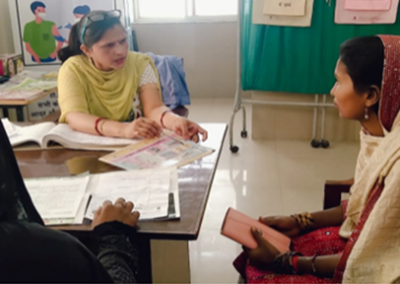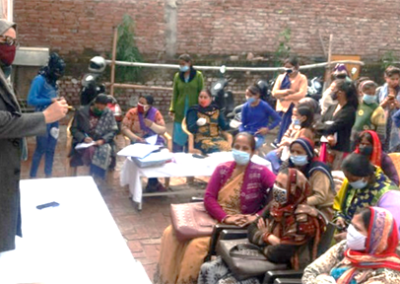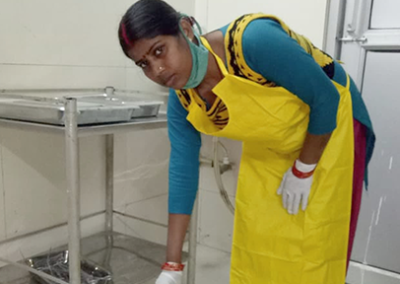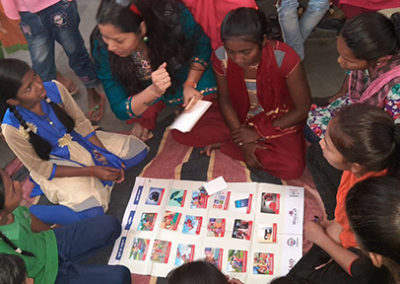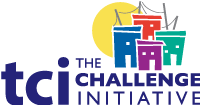India Toolkit: Services & Supply
- Home
- Help and Support
- Close
- Toolkits
- Global Toolkit
- AYSRH Toolkit
- Hub Toolkits
- Core High-Impact Practices
- Gender Essentials Mini Course
- Close
- Resource Collection
- Community of Practice
- Coaching
- Log In/Register
- My Profile
- English
Increased Postpartum Family Planning Services Results In Improved Maternal And Child Health
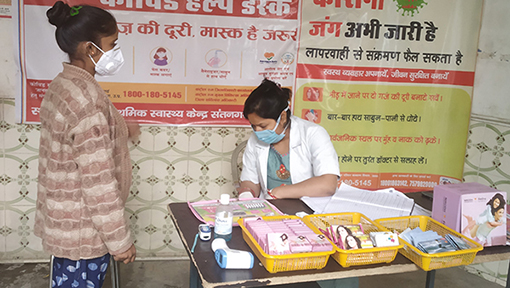 Purpose: Facility-based childbirth services offer an ideal opportunity to reach women and their partners with family planning (FP) information and services. Postpartum Family Planning (PPFP) thus has an important role to play in strategies to reduce the unmet need for FP. This tool coaches on the implementation of PPFP services for offering family planning basket of choice, including long-acting reversible contraception (LARC) and spacing methods, at urban primary health center (UPHCs), other higher order public facilities and private sector health facilities.
Purpose: Facility-based childbirth services offer an ideal opportunity to reach women and their partners with family planning (FP) information and services. Postpartum Family Planning (PPFP) thus has an important role to play in strategies to reduce the unmet need for FP. This tool coaches on the implementation of PPFP services for offering family planning basket of choice, including long-acting reversible contraception (LARC) and spacing methods, at urban primary health center (UPHCs), other higher order public facilities and private sector health facilities.
Audience:
-
General Manager (GM) FP and Urban
-
Joint Director/Additional Director (JD/AD)
-
Chief Medical Officers (CMO)/Additional Chief Medical Officer (ACMO)
-
Chief Medical Superintendents (CMS)
-
Divisional Urban Health Consultant (DUHC)/Nodal Officers – Urban Health and Family Planning/District Program Manager (DPM)/Urban Health Coordinator (UHC)
-
Medical Officer In-Charge/Medical Officers (MOICs/MOs)/Persons In-Charge of Private Facilities/Staff Nurse-In-Charge District Hospital
-
Facility Counsellor
Background: Evidence suggests that 61% of women do not use effective contraception within 24 months postpartum to avoid an unintended pregnancy. Because unintended and closely spaced births are associated with increased maternal, newborn and child morbidity and mortality, postpartum women are among those with the greatest unmet need for FP. However, providers, women and their support networks city concerns about contraceptive side effects, especially related to effects of hormonal contraceptives on breast milk and the child’s health as reasons to avoid contraception during the postpartum period.
It is, therefore, critical to address this grave public health concern so that PPFP can help couple decide which contraceptive they want to use, initiate that contraceptive and continue its use for two years or longer, depending on the reproductive intentions of the woman or couple.
Evidence of Impact
Investing in family planning reduces the maternal mortality rate (MMR) by 30% and the postpartum period is the most opportune time when a couple is actively seeking family planning to avoid a quick and unwanted pregnancy. TCI India conducted whole-site orientation (WSO) efforts through master coachees, the Chief Medical Superintendents’ (CMS) of the district women’s hospitals who oriented all facility staff on the family planning basket of choice methods and also became intentional on tapping PPFP. They started reviewing and seeking periodic reports on total delivery load and PPFP acceptors from the district women’s hospital (DWH) counsellor and ensured timely and correct reporting over HMIS. With these efforts, the government witnessed a 39% increase in total PPFP acceptors from the previous year ending in June 2021 (33,613 in June 2021 and 46,762 in February 2022), from the total delivery load.
Guidance on Implementing PPFP
PPFP should not be considered a “vertical” program in isolation. Rather, it should be integrated with existing maternal and child health and family planning programming efforts. A successful PPFP implementation strategy keeps people at the center of health care and it is gender intentional. Listed below are steps to implement an effective PPFP strategy:
Step 1: Understand the Health System and Current Government Policies
As a first step, devise a clear understanding of how the health system is organized. Understand private health care facilities/providers along with public health facilities that can offer PPFP and identify existing gaps and opportunities for offering FP to postpartum women.
Step 2: Make PPFP Data Visible by Estimating the Unmet Need for FP Based on Available Data
To amplify how health systems must focus on and prioritize PPFP, data from district and private facilities on reported delivery caseload vs. reported post-partum family planning uptake – should be analyzed and discussed with CMS and private providers and also at other appropriate city- and state-level FP monitoring meetings. PPFP uptake data disaggregated by age, parity and method choice is critical for a city to plan its PPFP strategy to reach women with unmet need for PPFP.
Step 3: Integrate PPFP across Contact Points
| Service | PPFP Integration |
| 1. Antenatal Care (ANC) |
|
| 2. Labor and Delivery, including Pre-discharge |
|
| 3. Postnatal Care (PNC) |
|
| 4. Immunization and Child Health Care Visits |
|
Step 4: Ensure Facility-based Counseling and Intrapartum Services
The MOIC, CMS, facility-in-charge of private facilities should coach facility staff to integrate PPFP at all the contact points listed in step 3 and to ensure couple counseling and encourage the couple to have open discussion about all the decisions including family planning choices. They should emphasize that counseling includes the expanded choice of FP methods, including long acting reversible contraceptives (LARCs) and also touches upon elements of gender equality and eradicating gender discrimination, like use of simulation games by counselor/ANM/staff nurse on gender sensitization such as white and black marble game to change the mind-set of son preference, Kranti Bhranti an interactive game of Rashtriya Kishore Swasthya Karyakram (RKSK) and creating awareness on Pre-Conception and Pre-Natal Diagnostic Techniques (PCPNDT), etc. They should assign responsibilities to ensure that commodities, supplies, equipment, human resource, requisite reporting forms and information, education and communication (IEC) materials are available for PPFP counseling. The service providers should also encourage male partners to promote shared decision-making and support for contraceptive use.
Step 5: Strengthen Human Resource Capacity
Strengthen policies and practices to address staff development and retention to ensure that providers with PPFP skills are available for providing services at the time of ANC, labour, delivery and PNC. This includes:
- Introducing and strengthening a comprehensive reproductive health (RH) education curriculum that addresses safe motherhood, family planning, neonatal and child health training issues.
- Ensure couple counselling on PPFP healthy timing and spacing (HTSP) during ANC and in teaching curriculum, practical training and examinations.
- Ensuring that all staff is oriented on gender integration and neutrality.
- Dispatching mobile outreach teams (while linking referrals to a static facility) to facilities in the short term to provide services while building staff capacity for the long term.
- Focusing on community-based PPFP interventions, including Exclusive Breast Feeding (EBF), pills, injectable and condoms, FST, NSV etc. while addressing provider capacity needs at the facility level
Step 6: Ensure Adequate Trained Staff, Equipment and Supplies, and If Possible, Ensure their Availability 24 Hours a Day, 7 Days a Week
The Janani Suraksha Yojana (JSY) scheme has resulted in an increased number of institutional deliveries at facilities across India. This has provided the opportunity to provide LARCs such as PPIUCD to women who desire to use these methods. However, many of these opportunities are missed because providers in the facilities lack the necessary skills to provide immediate postpartum IUCD insertion. Training a core group of providers at the district women’s hospital and in medical colleges can create the necessary technical capacity among nurses and other doctors to provide this service. Funding is available through the Program Implementation Plan (PIP) to train doctors and nurses from each public facility conducting deliveries.
Wherever feasible, ensure systematic 24/7 PPFP counseling through PPFP-trained providers and their availability during odd hours and on weekends. In addition, CMS should conduct whole-site orientations to ensure that staff nurses, traditional health workers or dais, janitors and cleaning staff are properly trained to support PPFP. In addition, organize client flow from OPD, ANC visits, labour, delivery and postnatal wards to identify appropriate space for counselling. A session on ‘values clarifications’ is often useful at the time of whole-site orientation (WSO) in debunking provider bias. In addition, preposition supplies and organize client flow through labor, delivery and postnatal wards to identify appropriate space for counseling. For more details, please refer to these WSO training guidelines.
Step 7: Ensure Clinical Safety for the Desired Method
An important consideration when planning a PPFP intervention is clinical safety, that is, which methods can be used at what point in time following birth and given the mother’s breastfeeding status.
According to WHO Medical Eligibility Criteria for Contraceptive Use (2015), women can safely use contraceptive implants alongside most of the other contraceptive options in the immediate postpartum period. This is further broken down for breastfeeding and non-breastfeeding women.
- FP options for breastfeeding women: Intrauterine devices (IUD), implants, progestogen-only pills, lactational amenorrhea method (LAM), condoms, male sterilization and female sterilization.
- FP options for non-breastfeeding women: IUDs, implants, injectables, condoms, emergency contraception, combined oral contraceptives (commence 21 days after delivery), male sterilization and female sterilization.
Step 8: Mobilize the Community
Orient Accredited Social Health Activists (ASHAs) on PPFP, HTSP, couple counseling, importance of inter-spousal communication to promote shared decision-making and support for contraceptive use.
- ASHAs should promote early PNC visits for home births and provide essential newborn care and EBF guidance, and also encourage the couple to have open discussion about all the decisions including family planning services. Arogya Mela, Saas bahu beta Sammellan, and urban health nutrition day (UHND) are relevant platforms for couple counselling.
- Discuss couple’s reproductive intentions for spacing or limiting and provide information on contraceptive methods and where to get them.
- Use community-based integrated MNCH/FP services
Step 9: Update National Service Delivery Guidelines and Clarify the Role of Service Providers
This is particularly critical if existing guidelines reflect delayed start of progestin-only methods, like implants, which are now an option for immediate PPFP use according to WHO’s 2015 Medical Eligibility Criteria for Contraceptive Use (5th edition). Guidelines as well as job descriptions should clearly articulate that all antenatal and maternity care providers have a role in PPFP, and that it is not just the responsibility of a few trained providers. The role of community health workers in promoting PPFP can also be specified.
Roles and Responsibilities
Role |
Responsibility |
| GM FP and Urban |
|
| JD/AD |
|
| CMO/ACMO |
|
| CMS/ MOIC/Facility In-Charge (in the case of private facilities) |
|
| Nodal Officer – Urban Health and FP/DUHC/DPM/UHC |
|
|
Staff Nurse/Facility Counsellor
|
|
|
Community Health Worker (ANMs, ASHAs, etc.)
|
|
Monitoring PPFP Services
PPFP counselling and services can be monitored by including this as a regular agenda item for discussion in the meetings convened by the CMS and CMO. The following indicators should be reviewed:
- # of facilities providing PPFP
- # of service provider’s capacity built (trained) on PPFP
- Number/percentage of ANC clients who received information and counselling regarding PPFP
- Number/percentage of ANC clients who have chosen a FP method in the postpartum period, and mark it on their ANC card/client card
- Proportion of women who select a method during ANC and receive it prior to discharge
- Proportion of maternity clients who request a method during early labor or pre- discharge counselling and receive their desired method before leaving the facility
- Number of FP clients served through PPFP, and their method-mix distribution
- Percentage of FP clients served through PPFP vis-a-vis total FP clients served, by method and by month
- Client-provider ratio for sterilization (to ensure that client safety and quality of care is not compromised)
Further, spot checks from client records and exit interviews by the CMS/CMO/ACMO- Nodal/DUHC/UHC and by in-charge of private facility to identify the reasons for which women who did not chose a family planning method post-delivery can provide important information on quality of care and provider-driven barriers to services.
For data quality purposes, it is recommended to maintain separate records for PPFP services. A summary of uptake of PPFP services vis-à-vis delivery case load must be maintained in the routine FP register.
Cost Elements
The elements required for PPFP are mentioned below along with their Program Implementation Plan (PIP) codes for easy reference. They may be covered under existing budget line items, but if not, they should be incorporated through the PIP process. Any additional support can also be sought from the flexi-pool. Specific costs include the following:
| Cost Element | FMR Code |
| Counselor hiring |
FMR-HSS.9.184.C.S0522
|
|
Training
|
Comprehensive PPIUCD Training for CHOs/SNs/ANMs – FMR-RCH.6.44.CB.1 |
| Incentives Sterilization, PPIUCD |
PPIUCD incentive to ASHA – FMR-RCH.6.44.ASHA.1 Antara incentive to ASHA FMR-RCH.6.45.ASHA |
| Compensation to client |
PPIUCD Compensation to client FMR-RCH.6.44.DBT.2 PPFST Compensation to client FMR-RCH.6.42.DBT.01.b) |
| Performance-based incentives for providers | PPIUCD insertion incentive for MO/SN/ANM in Urban FMR- HSS(U).5.143.OOC.1 |
| Performance-based incentives for counsellors | FMR-HSS(U).5.143.OOC.3 |
*Source: NHM PIP Guideline 2022-2024
This table is indicative and illustrates the manner in which cost elements are provisioned in a government PIP, thus giving guidance to the audience on where to look for elements related to a particular task.
Sustainability
Sustainability of PPFP can be achieved through the following measures:
- Providing family planning couple counseling and offering modern contraception as part of childbirth services and prior to maternity discharge increases postpartum contraceptive use.
- Understanding barriers to PPFP uptake and tailoring programmatic approaches to address those barriers can improve uptake.
- Consider home visits for covering PPFP adoption among home births and first-time, young parents.
- Consider leveraging antenatal care visits to educate clients on Doing so allows women to fully explore their intentions and to make an informed decision about contraception before delivery. Counseling earlier during a pregnancy may be particularly helpful if introducing IUD or sterilization as women often need more time to consider and discuss these options with their partners.
- Male involvement during and after pregnancy can reduce the occurrence of postpartum depression and improve use of maternal health services, such as skilled birth attendance and postnatal care. Providing men and women the opportunity to engage in family planning discussions as part of maternity care – together or separately – can directly address these inequitable norms and create space for joint decision-making for effective use of family planning.
- Ensure that providers have the skills and knowledge to provide all methods. Ensure periodic refresher training of service providers on method techniques.
Time to time orientation on ‘values clarifications’ of all service delivery staff to demystify myths.
TCI APP USERS PLEASE NOTE
You will only receive CERTIFICATES by email – when earning a score above 80% – and will not be able to view or print a certificate PDF from the TCI app.
Test Your Knowledge
Earn a Certificate
Quiz Summary
0 of 3 Questions completed
Questions:
Information
You have already completed the quiz before. Hence you can not start it again.
Quiz is loading…
You must sign in or sign up to start the quiz.
You must first complete the following:
Results
Results
0 of 3 Questions answered correctly
Your time:
Time has elapsed
You have reached 0 of 0 point(s), (0)
Earned Point(s): 0 of 0, (0)
0 Essay(s) Pending (Possible Point(s): 0)
Categories
- Not categorized 0%
- 1
- 2
- 3
- Current
- Review
- Answered
- Correct
- Incorrect
-
Question 1 of 3
1. Question
Unintended and closely spaced births are associated with increased maternal, newborn and child morbidity and mortality.
CorrectIncorrect -
Question 2 of 3
2. Question
When is the postpartum period?
CorrectIncorrect -
Question 3 of 3
3. Question
Why don’t women seek FP services in the postpartum period?
CorrectIncorrect


